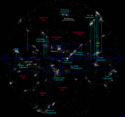Włókno (astronomia)
Włókno – jedna z największych struktur Wszechświata. Włókna wyglądają jak ogromne nici, ciągnące się na przestrzeni od 70 do 150 megaparseków, tworząc granice pomiędzy ogromnymi pustkami. Są skupiskiem gromad i supergromad galaktyk.
Galeria
Wszechświat w promieniu 1 miliarda lat świetlnych (307 Mpc) od Ziemi, z czytelną strukturą włókien i rozdzielających je pustek
Tworzenie się wielkoskalowych struktur Wszechświata. W sześcianie o rozmiarach 43 × 43 × 43 megaparseka przedstawiono ewolucję struktury wielkoskalowej w okresie (w skali logarytmicznej) począwszy od wartości przesunięcia ku czerwieni wynoszącej 30 a kończąc na przesunięciu ku czerwieni o wartości 0. Model pokazuje, jak regiony o gęstej materii kurczą się na skutek sił grawitacji, a jednocześnie powoduje to ekspansję pustek kosmicznych, ponieważ materia ucieka do włókien.
Zobacz też
- Wielka Ściana
- Wielka Ściana Sloan
- Ściana Rzeźbiarza
Media użyte na tej stronie
This graphic represents a slice of the spider-web-like structure of the universe, called the "cosmic web." These great filaments are made largely of dark matter located in the space between galaxies. Credit: NASA, ESA, and E. Hallman (University of Colorado, Boulder)
Autor: Richard Powell, Licencja: CC BY-SA 2.5
Map of voids and superclusters within 500 million light years from Milky Way
Autor: Andrey Kravtsov (the University of Chicago) and Anatoly Klypin (New Mexico State University), Licencja: CC BY 3.0
The simulation illustrates the formation of clusters and large-scale filaments in the Cold Dark Matter model with dark energy. The frames show the evolution of structures in a 43 million parsecs (or 140 million light years) box from redshift of 30 to the present epoch (upper left z=30 to lower right z=0). The simulation was performed at the National Center for Supercomputer Applications by Andrey Kravtsov (the University of Chicago) and Anatoly Klypin (New Mexico State University).
Autor: Richard Powell, Licencja: CC BY-SA 2.5
The universe within 1 billion light years of Earth, showing local superclusters. Approximately 63 million galaxies are shown.







